From Spark to Pixel (Part 1)
Second part of the visit of the exhibition From Spark to Pixel. Art + New Media, which is running at Martin Gropius Bau in Berlin until 14 January 2008.
Christian Partos had some impressive installations.
M.O.M. – Multi Oriented Mirror pixelises the artist’s mother’s portrait with 5000 micro-mirrors whose infinitesimal slant makes the intensity of the reflected light vary. If you stand close to the installation all you see is just lots of tiny bits of mirror. Take a few steps back and the the portrait of Partos’ deceased mother appears. The effect is really amazing. No picture of it in the press kit, sorry. I made this blurry image which might give you a very vague idea of what it was like.
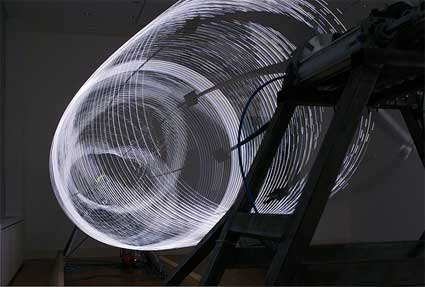 Christian Partos: Visp, 2000. photo: Lepkowski Studios
Christian Partos: Visp, 2000. photo: Lepkowski Studios
The Swedish artist had another work on show, Visp, a continuously changing shape made of 5 light-wires, 30 feet long, spinning like skipping-ropes, two revolutions per second. A computer, which also revolves, switches the LEDs on and off to create animated patterns on the revolving surface. Bitmap pictures, text etc. can be sent to the sculpture via radio link. Made for the Swedish Pavilion Expo 2000, Hanover.
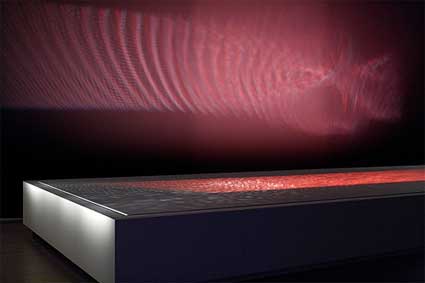 Thomas McIntosh with Emmanuel Madan and Mikko Hyninnen, Ondulation, 2002. Photo: Lepkowski Studios
Thomas McIntosh with Emmanuel Madan and Mikko Hyninnen, Ondulation, 2002. Photo: Lepkowski Studios
Ondulation, by Thomas McIntosh in collaboration with Mikko Hynninen and Emmanuel Madan is a truly hypnotizing composition for water, sound and light. A two-ton pool of water is set in motion by powerful loudspeakers. Waves travel across the basin, rising or falling in response to the sounds. Lights, bouncing off the moving surface, send reflected ripples over the walls of the gallery. The surface of this “liquid mirror� is slowly shaped by the sound into a kind of 3D expressions of the music which in turn become reflections on the wall. The simultaneity is such between the sound and light waves that we are left with a sense of seeing the sound and hearing the image.
Shiro Takatani (whom you might remember for a work Vicente recently reviewed: LIFE: fluid, invisible,inaudible… ) had some lovely installations and that’s is too bad for you if you can’t go and see the exhibition in Berlin because, once again, the press kit snubbed him. Chrono, a fiberglass cone recreates the exactitude of each pixel of an almost infinite number of fish-eyed images of skies shot in one day in Australian desert. Camera Lucida was commissioned for the retrospective of the nuclear physicist Ukichiro Nakaya (1900-1962) by the Museum of Natural History at Riga. Nakaya was the first to perform a systematic study of snow crystals and their different shapes. Camera Lucida is an intimate piece using fibre optics to explore the micro building blocks of nature.
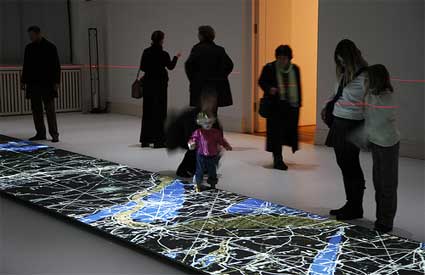 Dumb Type, Voyages, 2002. Photo: Jirka Jansch
Dumb Type, Voyages, 2002. Photo: Jirka Jansch
Takatani is one of the founders of Dumb Type. The Kyoto-based collective is showing Voyages, a work which brings to light the feelings of uncertainty and dislocation that accompany today’s shifting realities. Images of nature and other scenes are projected upon a narrow panel on the floor, circles showing a network of flight routes are superimposed. Visitors are invited to remove their shoes, step on the panel and embark on a journey through these multilayered realities. By adjusting their upheld palm to “catch” a projected circle, they can bring a “handheld” image into focus.
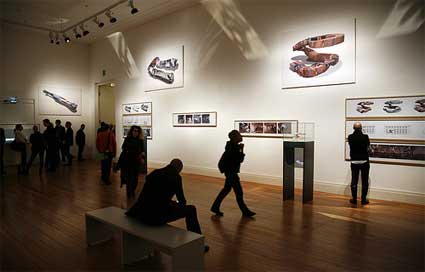 Joachim Sauter, Dirk Lüsebrink, ART+COM, The Invisible Shapes of Things Past, 1995–2007. Photo: Jirka Jansch
Joachim Sauter, Dirk Lüsebrink, ART+COM, The Invisible Shapes of Things Past, 1995–2007. Photo: Jirka Jansch
Joachim Sauter and Dirk Lüsebrink (Art + Com) had a room filled with architectural objects and sculptures generated from existing film stills, using a method they developed in the ’90s and which they call The Invisible Shapes of Things Past. The project enables users to transform film sequences into interactive, virtual objects.
In The Invisible Shapes of Things Past stills of a film sequence are arranged in a row in accordance with the camera movement with which they were shot. Thus, a straight camera movement produces a cube-shaped object and a pan a cylindrical object.
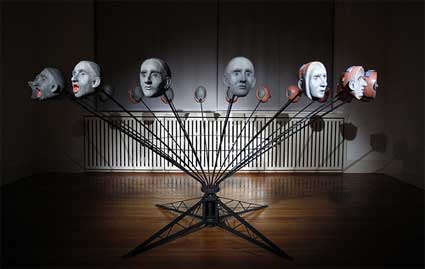 Gregory Barsamian, The Scream, 1998. Photo: Jirka Jansch
Gregory Barsamian, The Scream, 1998. Photo: Jirka Jansch
Gregory Barsamian uses relatively simple technoloty (strobe lights and motors) to transform his dreams into 3D animations. Using the idea of the zoetrope, the 19th century automated flipbook, Barsamian utilizes strobe lights synchronized to objects mounted on rotating armatures to create series of rapidly changing images. For each flash of the stroboscope, one sculpture representing a stage of the metamorphosis follows after the other, giving the impression of a constant transformation of its shape. Through the “persistence of vision,” the human mind transforms the images into the illusion of motion. An animation without the film.
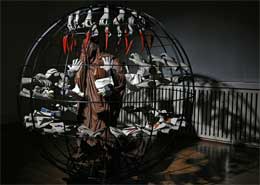 Video of one of his pieces.
Video of one of his pieces.
The Scream is a self portrait which concerns the issue of mind clutter: bits of unwanted information, songs and sound loops, images and nonsense syllables. In this piece a head emits a scream. The mouth widens and widens not stopping until the head turns inside out revealing some of the detritus within.
Image on the right: Greg Barsamian, No Never Alone, 1997. Photo: Jirka Jansch
The name of another of Barsamian’s installation, No, Never Alone, is taken from a Christian spiritual. A central figure is shrouded and thus blinded. The figures surrounding it are constantly taunting it for its intentional blindness. Hands dangle a carrot in front of it as well as show it an eye chart that it obviously cannot see. Another pair of hands holds an open book on whose pages dances a blind dervish while hands clap in time.
Here’s a slideshow of the exhibition. Please do not forget the credits for each image if you use any.
